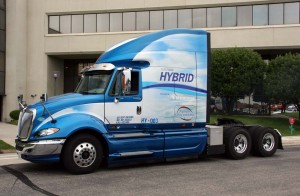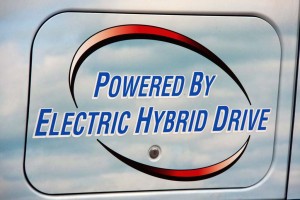
ArvinMeritor's diesel-hybrid truck could reduce fuel consumption by 15% - saving the typical trucker over 3,000 gallons of diesel annually.
The popular Cash-for-Clunkers program has helped spotlight efforts to improve automotive fuel economy. But that ignores what are quite literally the biggest gas guzzlers on the road: the nation’s fleet of heavy-duty trucks.
Typically in use 24/7, it’s common for a Class 8 truck to log more than 100,000 miles a year, and 6 miles per gallon is considered good fuel economy. That could change, if the Detroit-based supplier ArvinMeritor can move from concept to production with a heavy-duty hybrid-electric truck cab it is developing. The lithium ion-based system should reduce the typical trucks fuel consumption by 15 to 20%, company officials told U.S. Energy Secretary Carol Browner during a late Monday meeting.
“Our estimate is that this configuration could save 3,000 gallons of diesel fuel a year,” the project’s director, Chad Mitts, later explained to TheDetroitBureau.com.
While Mitts declined to discuss the projected price of the Class 8 hybrid, he agreed that “a fair estimate” would be $25,000 to $40,000 above the typical $100,000 cost of a well-equipped truck cab with sleeper quarters. At that price, he said a trucker or fleet owner could potential achieve “payback” within three years – in other words, the fuel savings would more than cover the added cost of the hybrid system.

The ArvinMeritor system uses battery power up to 50 mph, then combines diesel-electric.
The average heavy duty truck is maintained in use for at least a decade, so the long-term savings could be substantial, both in terms of cash, and in the reduced use of imported oil — as well as the reduced production of global warming carbon dioxide.
If not for the “Powered by Electric Hybrid Drive” decals, the prototype diesel-electric cab would look much like a conventional Class 8 rig. But the conventional transmission system has been replaced by a sophisticated power-splitting system. The other telltale sign is a pair of stainless steel boxes, just behind the crew sleeping quarters holding the hybrid’s LIon batteries.
At speeds up to 50 mph, the concept truck operates as a serial hybrid. Its 435-horsepower Cummins diesel serves as a generator. The wheels are driven entirely by a set of electric motors generating between 250 and 450 hp. Above 50, the system seamlessly converts to a parallel hybrid, with the wheels powered by both the diesel and the electric motors.
Even standing still, the hybrid system could save fuel. Like passenger car hybrids, the system is capable of temporarily shutting down its big diesel engine while idling, automatically firing it back up when it’s time to move. And the cab could switch to pure electric power when a driver was “hoteling” at night. Today, the diesel engine has to remain running, even when the driver is in the back of the cab sleeping, to handle the vehicle’s air conditioning.
It took ArvinMeritor cab 24 months to bring the hybrid system from concept to working prototype. But Mitts and other company officials couldn’t say how long it would take to go the next mile, putting the technology into production. There are a number of obstacles to overcome, the executive cautioned.
That includes the basic integration of the diesel and electric drive trains, as well as the durability of the overall system. But battery technology is the most obvious challenge, much as it is for manufacturers working on hybrid sedans or hatchback electric vehicles.
The goal is to make sure lithium batteries are powerful and reliable enough, while maintaining affordability. Mitts said ArvinMeritor hopes to piggyback off battery research done by and for manufacturers like General Motors and Nissan – which debuted its LIon-powered Leaf hatchback, over the weekend.
He also hinted that ArvinMeritor might borrow a business model being discussed by Nissan and other makers; customers might purchase a vehicle, like the Class 8 cab, but lease the batteries at a reduced price tag.
Shifting focus from the auto industry to the commercial truck market, ArvinMeritor quite literally has a lot riding on its Class 8 diesel-hybrid concept. And it is looking at a variety of ways to push the prototype into production. It has already formed alliances with the heavy-diesel maker, Cummins, as well as truck manufacturer Navistar.
The meeting with Energy Secretary Browner was intended to win government support. ArvinMeritor is just one of many manufacturers and their suppliers looking for government financing under various federal measures aimed at improving the fuel economy of the nation’s motor vehicle fleet.
For his part, Mitts suggested a real world demonstration program, involving 100 of ArvinMeritor’s hybrids, would cost “north of $50 million.”
For his part, the supplier’s CEO, Chip McClure, insisted, “I’m sure” the company could go it without federal assistance, but he and other executives stressed that such money would speed the program up significantly.
Asked whether she saw the need to lend financial support, Browner sidestepped the question, suggesting only that she found the technology, “very, very exciting.” She did note that under the economic recovery measures put in place by the White House, early this year, there was significant funding reserved for cleaner, more fuel-efficient transportation.
“That was a significant down-payment on a different energy future,” the Energy Secretary said.
